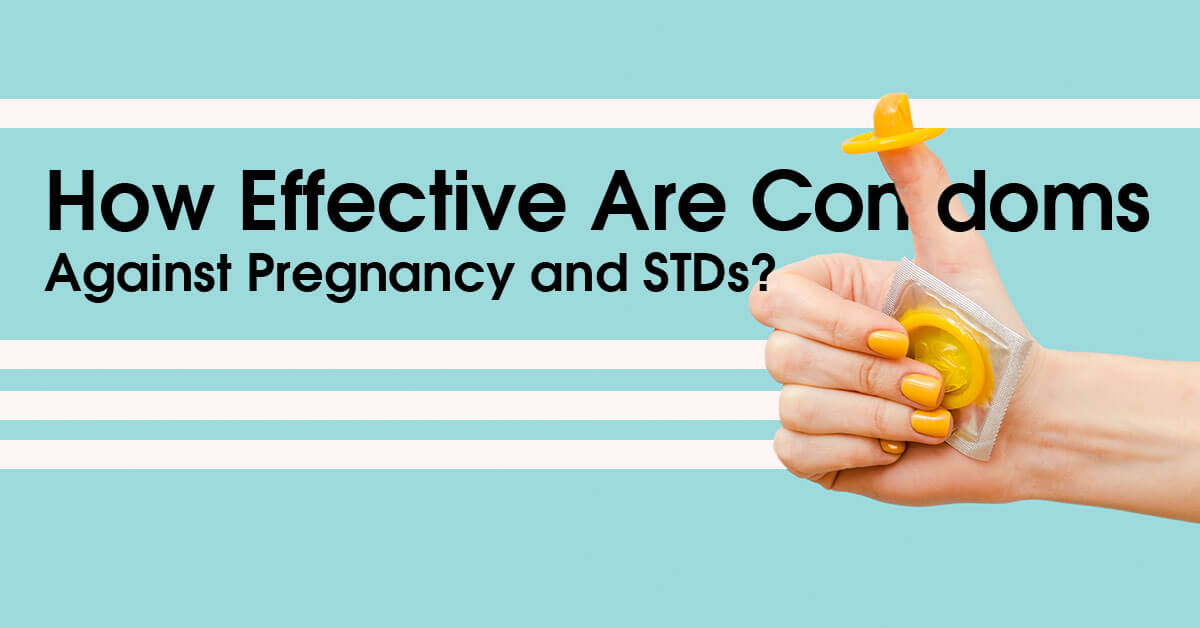
Condoms have been used since ancient Egyptian times. Today, they are one of the most convenient and affordable ways of birth control across the globe—being highly effective in the prevention of sexually transmitted diseases and pregnancy.
But how effective are condoms really? This article will take an in-depth look at the various types of condoms, their effectiveness, and their use.
Key Takeaways
- The commonly used male condom is a thin sheath worn on the penis during sex. It prevents pregnancies and the transfer of STDs.
- The effectiveness of condoms depends on proper use. For the best results, use condoms before they expire and store them in the right manner.
- Condoms with spermicides are not the best options to prevent STDs. They can lead to infections and irritations.
- Among the various types available, latex condoms are the best option in terms of protection. Those suffering from latex allergies can use polyisoprene condoms.
- The size of a condom depends on the width and length of the penis. Make sure to pick the right size for the best effectiveness.
Effectiveness of Condoms
Studies conducted on some of the best male latex condoms have proven that they have high contraceptive efficacy. Condoms are also one of the best forms of protection against HIV and other STDs.
Pregnancy
Condoms are the only non-surgical form of male contraception to prevent pregnancy.
Commercial varieties of latex condoms have proven to be highly effective as a birth control method. The rate of breakage or slippage during intercourse was also considerably lower with latex condoms [1][2].
For users with latex allergies, polyurethane or polyisoprene condoms could be an effective substitute.
Which of the following contraceptive methods is most effective?
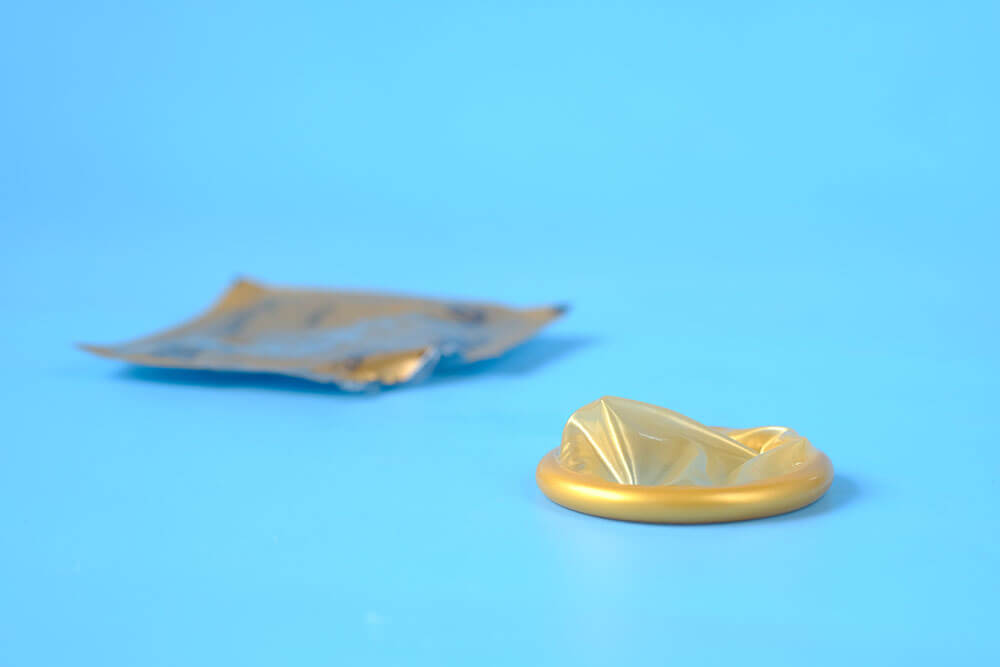
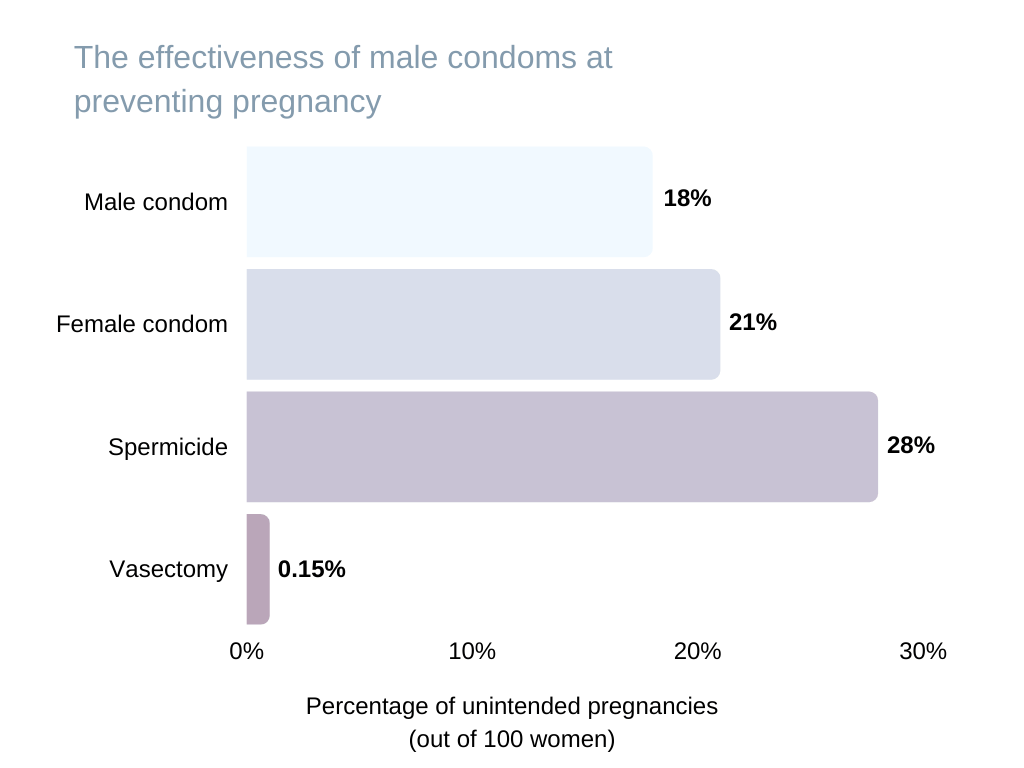
STDs
The low failure rate of latex-based condoms makes them very effective in preventing sexually transmitted diseases. The use of condoms also lowers the chances of disease transmission during oral or anal sex [3].
Since the chances of condom breaks are higher with polyurethane condoms, they are less reliable for preventing sexually transmitted infections.
Researchers have also pointed out that females are more vulnerable to sexually transmitted diseases, primarily due to socioeconomic conditions [4]. Therefore, the use of female condoms can be a more viable option in such cases.
Failure and incorrect use of condoms can result in serious health risks during alternative sexual practices or outercourse.
Can You Make Condoms More Effective?
While condoms are very effective to prevent pregnancy, they do not offer 100% protection. As per estimates, when used perfectly, the chances of condom break are around 3%. However, in general, the failure rate of condoms is around 12% [5].
Keeping the following points in mind can make condoms more effective:
- Check the expiry date of the condoms and do not use them if they are too old.
- Store condoms away from extreme temperatures and bright light sources to prevent microtears.
- Use only water-based lubricants with a condom to prevent damage to the material.
- Make sure you wear a condom during the entire duration of intercourse.
- While removing the condom after ejaculation, be careful not to spill semen.
- Do not use male and female condoms at the same time as the friction can lead to breakage.
- In case the condom breaks, stop and withdraw the penis from the vagina immediately.
- Use condoms along with other forms of pregnancy prevention methods like a copper IUD or a birth control sponge.
In addition, the use of condoms reinforced with antimicrobial nanoparticles can reduce the risk of HIV and other sexually transmitted infections [6]. Termed as antiretroviral therapy (ART), this form of prevention is equally effective for vaginal or anal sex.
The therapy can be effective in reducing chain transmission and disease spread as the nanoparticles are not washed away by vaginal or anal secretions—such treatment can also reduce the chances of condom breakage.
Spermicide Condoms
Spermicidal condoms contain a special chemical that prevents sperm movements and ultimately kills the sperm. The natural movement of the sperm is towards the uterus through the cervix, however, the spermicide kills them off before they can reach the uterus to fertilize the egg.
What Is It
The most common chemical used as spermicide is nonoxynol-9 (N9). It is used in multiple forms like creams, jellies, gels, foams, and lubricants. N9 reduces the ability of the sperm to move and ultimately causes the sperm to die. It functions by reacting with the lipids on the surface of the sperm.
Effectiveness
There is no clear proof that spermicidal condoms are more effective in birth control than ordinary condoms. Spermicidal condoms cost more and have a shorter shelf life. Moreover, they have been linked with urinary tract infections in women. The CDC does not recommend the use of spermicides as a birth control method [7].
N9 can also cause vaginal or rectal irritation in women. This can increase the chances of HIV or STD infection from an infected partner [8]. In male partners, genital irritations have been reported in some cases. Presently, N9 is not considered as prevention against sexually transmitted diseases.

Source: https://www.ncbi.nlm.nih.gov/pmc/articles/PMC3332092/
How To Get Condoms
Condoms are one of the most widely available products for birth control and are easy to get. They are found in various stores and are also distributed for free from health centers.
Read more on how to get birth control.
Where To Buy Condoms?
Condoms can be bought from community health centers, drugstores, convenience stores, supermarkets, and online. There are condom vending machines in gas stations and campuses, in certain locations. There is no legal age for buying condoms and no prescription is required.
Keep in mind buying condoms is a normal process and there is no reason to feel embarrassed.
How Much Do Condoms Cost?
In general, a box of 3 condoms can cost around $2 to $6 depending on the brand. When you buy a pack of 12 or more, each piece costs approximately $1.
Types of Condoms
Condoms are available in a variety of types based on the material. It is best to know the type you want to use before purchasing a pack.
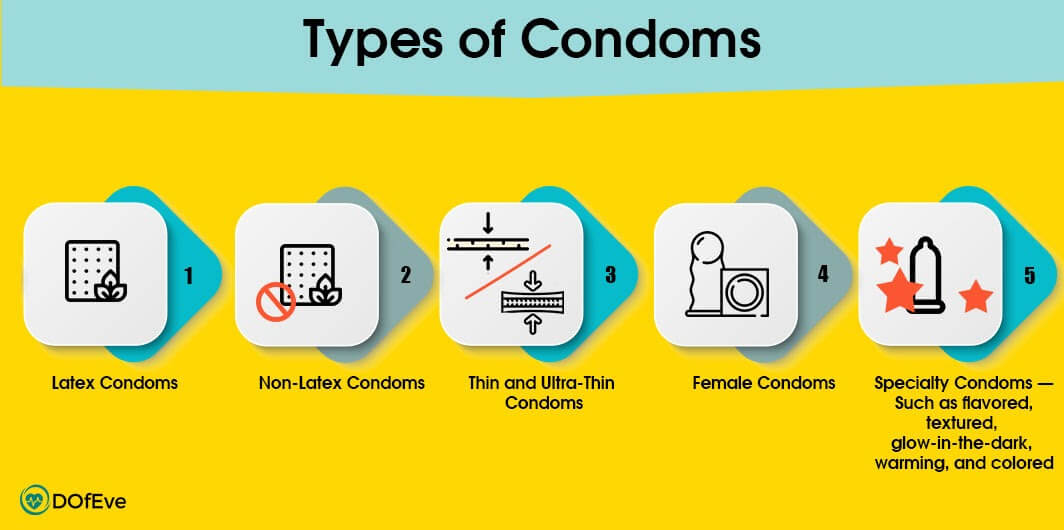
Latex Condoms
These are the most common forms of condoms and are made from natural rubber—it also makes them the most expensive variety. Latex condoms are the best choice for preventing pregnancy and STDs when used correctly.
One issue with latex condoms is the allergies they can cause in sensitive individuals. In case a rash or itch develops regularly after using a condom, consult a physician. However, make sure that the issue is not related to excessive dryness or the lubricant. Experts also recommend not using oil-based lubricants with latex condoms, which increases the chances of slippage.
Non-Latex Condoms
While these condoms are not as effective as latex ones, they can be used if you are uncomfortable with latex. Polyurethane and nitrile are some common latex alternatives.
Another form of synthetic rubber that is used is polyisoprene. Since polyisoprene is soft, stretchy, and does not trigger allergies, it’s an excellent material for condoms. However, some users do not prefer polyisoprene as they feel it is too thick.
The use of lambskin condoms is an ancient practice. A very thin material of the lamb’s intestine is used to make these condoms. They are as good as latex condoms for preventing pregnancies. However, the material is porous, making it ineffective for STD or HIV prevention. Besides, lambskin condoms are more expensive and are not easily available.
Thin and Ultra-Thin Condoms
These external condoms are made from super-thin latex, which provides extra sensation and transmits more warmth during intercourse. They are highly resistant to breakage and good for preventing pregnancy and STD transmission. Thin condoms are available in multiple shapes and may come in lubricated varieties.
Female Condoms
Female condoms are another barrier method of contraception, and are also 95% effective in preventing pregnancies when used correctly. In the case of typical use, the success rate is between 75% to 82% [9]. These condoms can be inserted hours before having sex and provide good protection against STDs.
Being internal condoms, they are less popular due to the difficulty in proper placement, removal, and issues related to the size.
Specialty Condoms
There are various special varieties of external condoms including flavored, glow-in-the-dark, warming, and colored. The outer surface of the condoms can have textures or ribs as well as additional design features to make them pleasure-shaped.
While the choice depends on personal preference, make sure the condoms you choose are FDA-approved and offer the right level of protection.
Which Material Is Best?
Overall, latex is the best choice in terms of effectiveness. In the case of latex allergy, you can opt for polyisoprene materials.
Quick Guide to Condom Sizes
The size of an external condom depends on the width and length of the penis. Choosing the wrong size can result in a condom break or slippage. The width of the condom is most important as the right dimension prevents the condom from slipping.
As per the usual conventions:
- A width of under 1.75 inches is a snug fit.
- A width of 1.75 to 2 inches is a standard fit.
- A width over 2 inches is a large fit.
In terms of length, the following guidelines are used:
- 7 to 7.8 inches for snug condoms.
- 7.25 to 7.8 inches for standard condoms.
- 7.25 to over 8 inches for large condoms.
How To Use a Condom: Step by Step Guide
Using the condom correctly is essential. Here are the steps for using a male condom without error:
- Start by opening the pack carefully, avoid using your teeth or any sharp object that could damage the condom.
- Take the condom out of the pack and put it over the tip of a hard and erect penis. Place the rim on the outside to unroll it correctly.
- Pinch the tip of the condom to expel the air. Unroll it down along the shaft of the penis till you reach the base. In case you are uncircumcised, it is best to pull back the foreskin before unrolling the condom.
- After ejaculation, pull out the condom by holding the base. Ensure that no semen leaks out over your partner.
- Throw the condom in the trash. Do not flush it down the toilet as it can clog the pipes.
Tips To Using Condoms
The following tips can help you to use a condom correctly:
- Always check the expiration date of the condom and use a new condom every time you have sex.
- Do not open a pack of condoms with your teeth or sharp instruments.
- For the best prevention against STDs, always put a condom on before the penis touches your partner’s skin.
- If you feel the condom break during sex, withdraw. Continue only after replacing the broken condom with a new one.
- Always change the condom when you go from vaginal sex to anal or oral sex or vice versa.
- Do not withdraw without holding the base of the condom with your hand.
Benefits of Condoms
Here are a few important benefits of condoms:
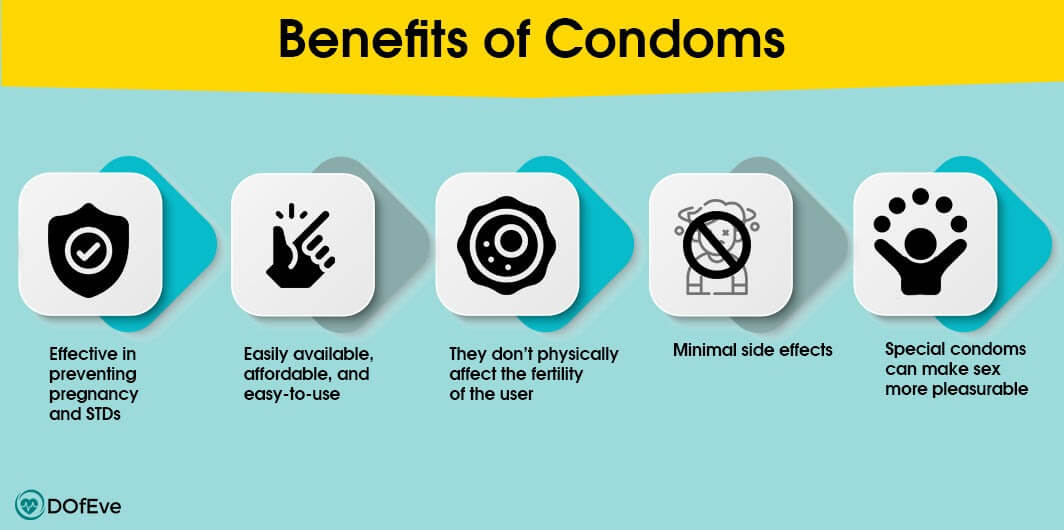
- Condoms are effective in preventing pregnancy and also protect both partners from various types of STDs.
- Condoms are easily available, affordable, and require no advance preparation for use—making them a good choice for unplanned sex.
- Being a use-and-throw device, they do not physically affect the fertility of the user. This makes them extremely effective for planned parenthood.
- There are hardly any side effects from their use.
- Since condoms come in various forms, they can make the act of sex more enjoyable and pleasurable.
Disadvantages of Condoms
Condoms are not entirely without disadvantages. Take a look at some of the major ones:
- During typical use or when used incorrectly, a condom can break or slip, resulting in an unwanted pregnancy.
- Some people are allergic to latex or plastic materials—making it difficult for them to use condoms.
- Some couples feel that sex with condoms is not as pleasurable as unprotected sex.
- Pulling out in the right manner after ejaculation while using a condom can be difficult to do each time.
FAQ
Time to address some of the common queries related to condoms.
Why Do Condoms Fail?
Condoms break or fail due to improper placement or the use of the wrong type of lubricant. It may also happen if the condom is too old or damaged. The use of a small or too large condom can also lead to failures.
Can You Get Pregnant While Using Condoms Correctly?
Yes, that is possible. No type of condom provides 100% protection from pregnancy or STDs.
How Effective Are Condoms if They Don’t Break?
When used perfectly condoms are almost 98% effective. But for an average user, they are around 85% effective.
Why Do Condoms Hurt My Girlfriend?
The problem can be related to a lack of lubrication. The use of additional lubricant of the right type can be effective. In some cases, women can be allergic to latex or the spermicide chemical used in some condoms.
Conclusion
Condoms are one of the easiest and most available male birth control methods. However, their effectiveness depends on the way they are used. With the right information, you can use condoms to enhance your sex life without compromising safety.
References
- Walsh TL;Frezieres RG;Peacock K;Nelson AL;Clark VA;Bernstein L;Wraxall BG; “Effectiveness of the Male Latex Condom: Combined Results for Three Popular Condom Brands Used as Controls in Randomized Clinical Trials.” Contraception, U.S. National Library of Medicine, pubmed.ncbi.nlm.nih.gov/15504381/.
- Walsh TL;Frezieres RG;Peacock K;Nelson AL;Clark VA;Bernstein L; “Evaluation of the Efficacy of a Nonlatex Condom: Results from a Randomized, Controlled Clinical Trial.” Perspectives on Sexual and Reproductive Health, U.S. National Library of Medicine, pubmed.ncbi.nlm.nih.gov/12729137/.
- Marfatia, Y S, et al. “Condoms: Past, Present, and Future.” Indian Journal of Sexually Transmitted Diseases and AIDS, Medknow Publications & Media Pvt Ltd, 2015, www.ncbi.nlm.nih.gov/pmc/articles/PMC4660551/.
- Aral, Sevgi O, et al. “Disproportionate Impact of Sexually Transmitted Diseases on Women.” Emerging Infectious Diseases, Centers for Disease Control and Prevention, Nov. 2004, www.ncbi.nlm.nih.gov/pmc/articles/PMC3329016/.
- Majra, Jp. “Use of Condoms: Clarifying the Message.” Indian Journal of Community Medicine : Official Publication of Indian Association of Preventive & Social Medicine, Medknow Publications, Apr. 2010, www.ncbi.nlm.nih.gov/pmc/articles/PMC2940206/.
- Yah, Clarence S, et al. “Nanotechnology and the Future of Condoms in the Prevention of Sexually Transmitted Infections.” Annals of African Medicine, Medknow Publications & Media Pvt Ltd, 2018, www.ncbi.nlm.nih.gov/pmc/articles/PMC5875119/.
- “Sexually Transmitted Diseases Treatment Guidelines —- 2002.” Centers for Disease Control and Prevention, Centers for Disease Control and Prevention, www.cdc.gov/mmwr/preview/mmwrhtml/rr5106a1.htm.
- “Nonoxynol-9.” National Center for Biotechnology Information. PubChem Compound Database, U.S. National Library of Medicine, pubchem.ncbi.nlm.nih.gov/compound/Nonoxynol-9#section=Drug-Warnings.
- Mokgetse, Moitlamo, and Mokholelana M Ramukumba. “Female Condom Acceptability and Use amongst Young Women in Botswana.” Curationis, AOSIS, 20 Sept. 2018, www.ncbi.nlm.nih.gov/pmc/articles/PMC6191681/.



Leave a Reply